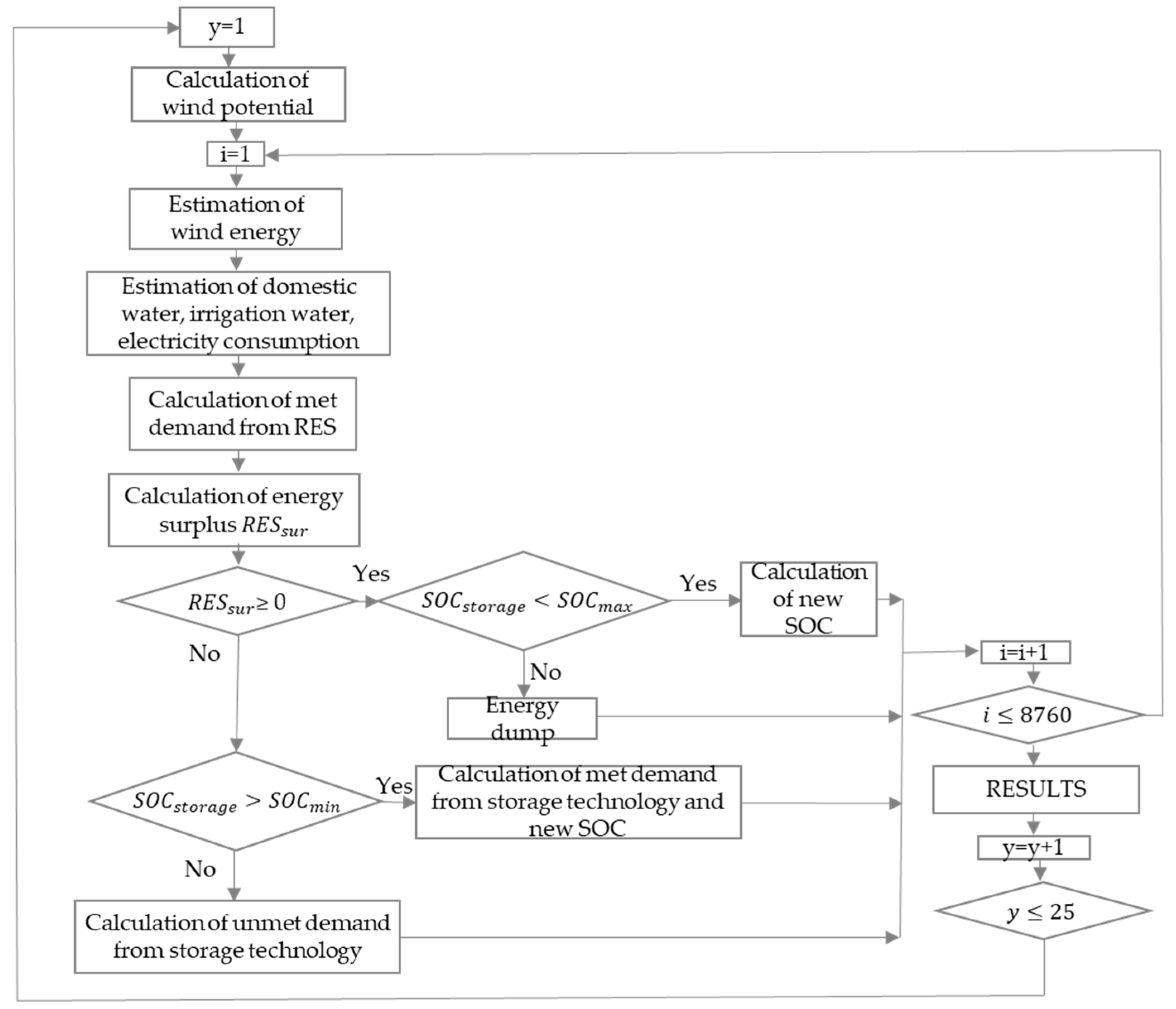Renewable Energy Sources: Transition towards Sustainable Development through the Water–Energy–Food Approach †
Abstract
:1. Introduction
2. Material and Methods
3. Results and Discussion
3.1. Coverage Rate of Energy Sources
3.2. Cost of Water and Cost of Energy
3.3. Average Values and WEF Nexus
Author Contributions
Funding
Institutional Review Board Statement
Informed Consent Statement
Data Availability Statement
Conflicts of Interest
References
- Brini, R. Renewable and non-renewable electricity consumption, economic growth and climate change: Evidence from a panel of selected African countries. Energy 2021, 223, 120064. [Google Scholar] [CrossRef]
- Chien, F.; Ajaz, T.; Andlib, Z.; Chau, K.Y.; Ahmad, P.; Sharif, A. The role of technology innovation, renewable energy and globalization in reducing environmental degradation in Pakistan: A step towards sustainable environment. Renew. Energy 2021, 177, 308–317. [Google Scholar] [CrossRef]
- Nazir, M.S.; Mahdi, A.J.; Bilal, M.; Sohail, H.M.; Ali, N.; Iqbal, H.M.N. Environmental impact and pollution-related challenges of renewable wind energy paradigm—A review. Sci. Total Environ. 2019, 683, 436–444. [Google Scholar] [CrossRef] [PubMed]
- Zsiborács, H.; Baranyai, N.H.; Vincze, A.; Zentkó, L.; Birkner, Z.; Máté, K.; Pintér, G. Intermittent renewable energy sources: The role of energy storage in the european power system of 2040. Electronics 2019, 8, 729. [Google Scholar] [CrossRef]
- Bertsiou, M.M.; Baltas, E. Energy, Economic and Environmental Analysis of a Hybrid Power Plant for Electrification, and Drinking and Irrigation Water Supply. Environ. Process. 2022, 9, 22. [Google Scholar] [CrossRef]
- Sánchez, A.; Zhang, Q.; Martín, M.; Vega, P. Towards a new renewable power system using energy storage: An economic and social analysis. Energy Convers. Manag. 2022, 252, 115056. [Google Scholar] [CrossRef]
- Ökten, K.; Kurşun, B. Thermo-economic assessment of a thermally integrated pumped thermal energy storage (TI-PTES) system combined with an absorption refrigeration cycle driven by low-grade heat source. J. Energy Storage 2022, 51, 104486. [Google Scholar] [CrossRef]
- Hunt, J.D.; Zakeri, B.; Lopes, R.; Barbosa, P.S.F.; Nascimento, A.; de Castro, N.J.; Brandão, R.; Schneider, P.S.; Wada, Y. Existing and new arrangements of pumped-hydro storage plants. Renew. Sust. Energ. Rev. 2020, 129, 109914. [Google Scholar] [CrossRef]
- Ishaq, H.; Dincer, I.; Crawford, C. A review on hydrogen production and utilization: Challenges and opportunities. Int. J. Hydrog. Energy 2022, 47, 26238–26264. [Google Scholar] [CrossRef]
- Escamilla, A.; Sánchez, D.; García-Rodríguez, L. Assessment of power-to-power renewable energy storage based on the smart integration of hydrogen and micro gas turbine technologies. Int. J. Hydrog. Energy 2022, 47, 17505–17525. [Google Scholar] [CrossRef]
- Lagouvardos, K.; Kotroni, V.; Bezes, A.; Koletsis, I.; Kopania, T.; Lykoudis, S.; Mazarakis, N.; Papagiannaki, K.; Vougioukas, S. The automatic weather stations NOANN network of the National Observatory of Athens: Operation and database. Geosci. Data J. 2017, 4, 4–16. [Google Scholar] [CrossRef]
- Papadopoulou, E.; Varanou, E.; Baltas, E.; Dassaklis, A.; Mimikou, M. Estimating potential evapotranspiration and its spatial distribution in Greece using empirical methods. In Proceedings of the 8th International Conference on Environmental Science and Technology, Lemnos Island, Greece, 8–10 September 2003; National Technical University of Athens: Athens, Greece, 2003; pp. 650–658. [Google Scholar]
- Bertsiou, M.M.; Baltas, E. Power to Hydrogen and Power to Water Using Wind Energy. Wind 2022, 2, 305–324. [Google Scholar] [CrossRef]
- Negra, N.B.; Holmstrøm, O.; Bak-Jensen, B.; Sørensen, P. Model of a synthetic wind speed time series generator. Wind Energy 2008, 11, 193–209. [Google Scholar] [CrossRef]



| WPHS | HFC | |
|---|---|---|
| WT (%) | 56.19 | 56.19 |
| WPHS (%) | 18.92 | - |
| HFC (%) | - | 17.12 |
| dWT (%) | 74.98 | 74.98 |
| irWT (%) | 57.71 | 57.71 |
| elWT (%) | 54.09 | 54.09 |
| dSTORAGE (%) | 11.31 | 10.35 |
| irSTORAGE (%) | 24.46 | 22.64 |
| elSTORAGE (%) | 19.10 | 17.15 |
| Cost of water (€/m3) | 1.580 | 1.787 |
| Cost of energy (€/kWh) | 0.270 | 0.305 |
| WFF (m3) | 92,322 | 90,293 |
| EFF (kWh/year) | 540,085 | 528,214 |
| WFE (m3/year) | 2,597,806 | 926.00 |
| EFW (kWh/year) | 443,084 | 457,096 |
| EFE (kWh/year) | 5,151,984 | 148,768 |
Disclaimer/Publisher’s Note: The statements, opinions and data contained in all publications are solely those of the individual author(s) and contributor(s) and not of MDPI and/or the editor(s). MDPI and/or the editor(s) disclaim responsibility for any injury to people or property resulting from any ideas, methods, instructions or products referred to in the content. |
© 2023 by the authors. Licensee MDPI, Basel, Switzerland. This article is an open access article distributed under the terms and conditions of the Creative Commons Attribution (CC BY) license (https://creativecommons.org/licenses/by/4.0/).
Share and Cite
Bertsiou, M.M.; Baltas, E. Renewable Energy Sources: Transition towards Sustainable Development through the Water–Energy–Food Approach. Environ. Sci. Proc. 2023, 26, 207. https://doi.org/10.3390/environsciproc2023026207
Bertsiou MM, Baltas E. Renewable Energy Sources: Transition towards Sustainable Development through the Water–Energy–Food Approach. Environmental Sciences Proceedings. 2023; 26(1):207. https://doi.org/10.3390/environsciproc2023026207
Chicago/Turabian StyleBertsiou, Maria Margarita, and Evangelos Baltas. 2023. "Renewable Energy Sources: Transition towards Sustainable Development through the Water–Energy–Food Approach" Environmental Sciences Proceedings 26, no. 1: 207. https://doi.org/10.3390/environsciproc2023026207






